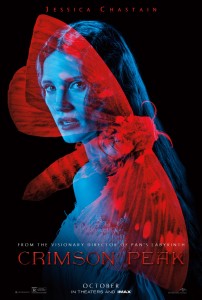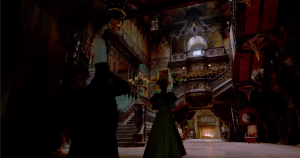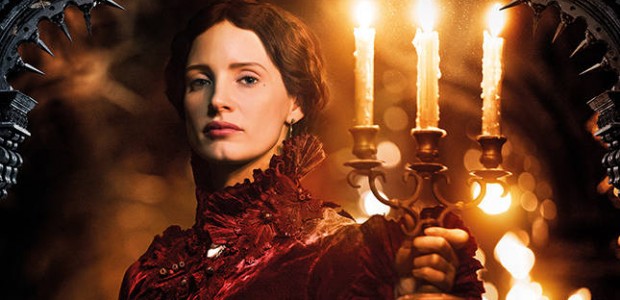Unearthing the Gothic is a monthly column where we explore the vast and exciting world of gothic horror media as a way to exhume it from the margins of conversation and preserve its importance to the genre.
For many a gothic horror fan, CRIMSON PEAK was a lush and atmospheric delight, but there were critics that did not feel the same way when it came to del Toro’s painstakingly beautiful love letter to an underappreciated subgenre of horror. It’s a gorgeous contemporary entry to the gothic that deserves a little bit more recognition and respect. I’ve always believed that time would be kinder to Guillermo del Toro’s CRIMSON PEAK.
CRIMSON PEAK certainly isn’t for everyone, but the film seemed to suffer most from the general public’s understanding of how gothic romance works in the first place. Maybe horror has become too far removed from its gothic origins and viewers are wholly divorced from the slow burn terror of a good old fashioned ghost story. A portion of reviewers made it a point to decry the film for being exactly what it should be, an unsettling conundrum that either, again, says something about the comprehension of gothic fare or maybe even more about the overall lack of media literacy. Regardless, some reviewers felt the need to become mindbogglingly catty about a film that
CRIMSON PEAK follows our intrepid heroine and aspiring novelist Edith Cushing (Mia Wasikowska) as she experiences a whirlwind romance with the charming and mysterious Sir Thomas Sharpe (Thomas Hiddleston). Sharpe and his sister Lady Lucille (Jessica Chastain) have come to ask Edith’s father (Jim Beaver) to invest in Thomas’s inventions. Edith and Thomas become instantly drawn to one another, however Edith’s caring father forbids the romance. After her father’s body is found with his skull caved in, Edith is free to marry Thomas and does so in her grief. Thomas whisks Edith away to his and Lucille’s dilapidated ancestral home Allerdale Hall, which is locally referred to as CRIMSON PEAK. (Insert pointing Leo DiCaprio Meme here.) The once beautiful estate is in disrepair and harboring more secrets and ghosts than young Edith could ever imagine. Gothic horror tropes abound in a most Guillermo del Toro way.

There were viewers that misunderstood the homage that felt like a lost entry into Hammer Horror’s illustrious gothic canon. If CRIMSON PEAK had been made in the 60s, it easily would have starred Christopher Lee as Sir Thomas Sharpe and likely would have been directed by the likes of Mario Bava himself — considering that CRIMSON PEAK owes a lot of its look and feel to The Whip and the Body. The amount of love that del Toro injects into the film is palpable. He loves this genre, this era of film, and he wants to introduce a whole new generation to a film tradition that has fallen out of fashion. The characters, the sets, the story, are all homage. However, some audience members didn’t seem to receive the same love letter that I and other viewers did. That’s entirely fine. I understand the gothic isn’t everyone’s cup of poisoned tea, but it does deserve some baseline understanding instead of outright obtuse revilement.
As a whole, CRIMSON PEAK has all the components that audiences truly love. It was marketed fairly faithfully, a chilly ghost story with lots of twists and turns. It has blisteringly hot romance and Tom Hiddleston, who has a most potent hold over the masses. Not only does it have Tom Hiddleston, it has Tom Hiddleston in one of his most unbearably hot roles. Yes, I said it; move aside, Loki. Jessica Chastain is giving one of her career best performances, showing that the art of the villainess is not a lost one. Hell, it has Charlie Hunnam, and I, for one, know that most middle aged moms out there adore one Mr. Charlie Hunnam in any project. The sets are more beautiful and articulated than most film’s concepts, and don’t get me started on the designs of the ghosts. Everything within the film is a superb treat, but it didn’t seem to translate to the audiences at the time, creating a mystery that might be more perplexing than the layers of secrets within the walls of Allerdale Hall itself.

CRIMSON PEAK is probably one of the best examples of how gothic horror refuses to go silently. It should have ushered in a revival of big budget romantic costume dramas with ghosts chasing young ladies carrying candelabras down halls, but that was not the case. It seems odd that audiences that were so keen on Francis Ford Coppola’s version of Dracula a little over a decade earlier were not charmed by del Toro’s own grand take on the subgenre. However, online sentiment has shifted toward our beloved CRIMSON PEAK, being the stalwart of contemporary gothic that it is. Even Super Yaki, the premiere clothing site of cinephiles and genre fans across the world, has gotten in on the CRIMSON PEAK praise with a shirt that is aptly called Crimson Preach. (It can be purchased here as a shirt and here as a sticker.) It’s been interesting to see the narrative surrounding a film that received such a bafflingly lukewarm reception shift and change in a relatively short amount of time.
Whether you hate or love CRIMSON PEAK, you have to admit that as a film it is one that is a creation of pure burning passion for a subgenre of horror that is weirdly maligned as being anything but horror. Maybe we are all foolishly short sighted, looking no further than more than 30 years in the past, eschewing all that came before as boring products of a bygone era. It’s disheartening. Preservation of horror should extend to all little corners of horror, even the corners you might not particularly like or understand, so the purpose of this piece is for you all to go out there and either re-watch CRIMSON PEAK and reevaluate it with new eyes or give it a watch if you skipped it due the mixed reception. Let’s make reevaluation a glorious norm, both for pure fun and scholarly pursuits.
Tags: Charlie Hunnam, Crimson Peak, Gothic Horror, guillermo del toro, Horror, Jessica Chastain, Mia Wasikowska, Tom Hiddleston, Unearthing the Gothic



No Comments